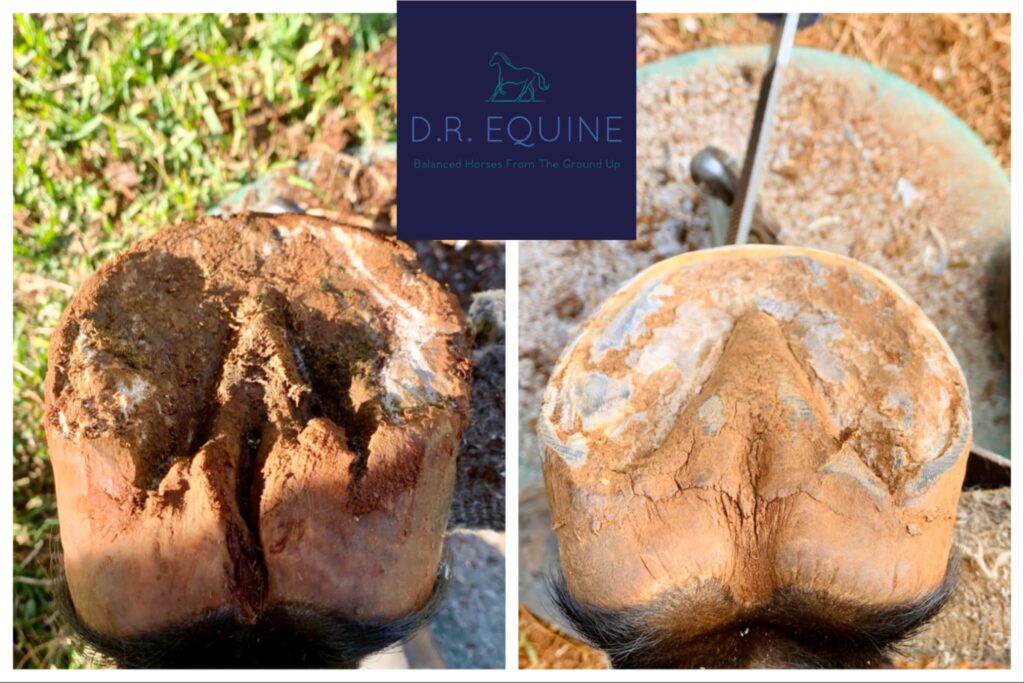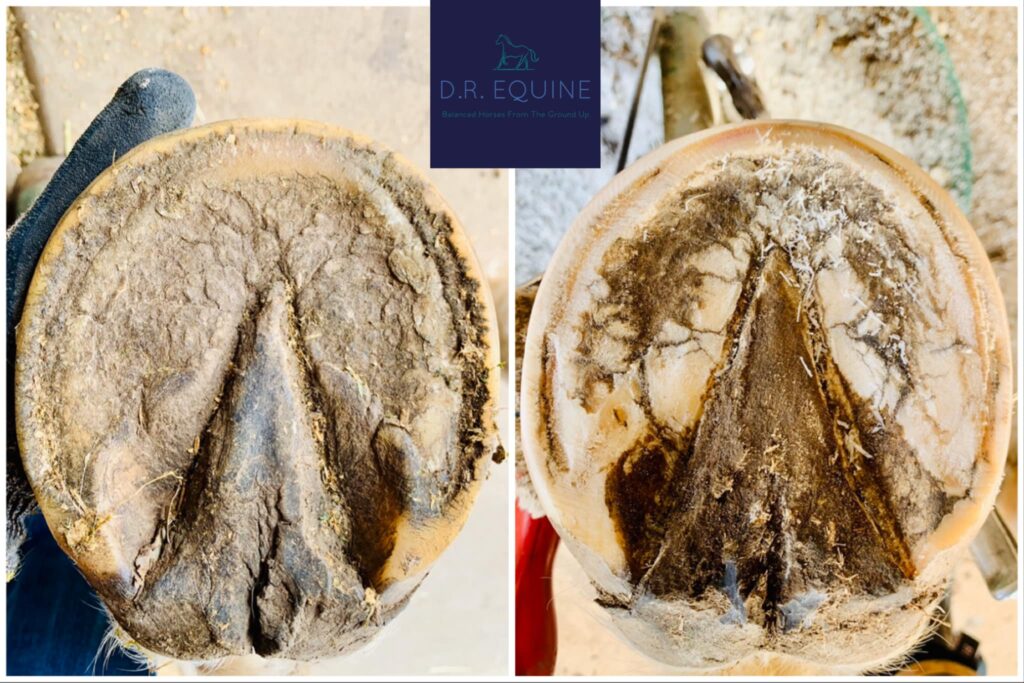Unfortunately for a lot of horses the answer would be, yes.
Thrush in the hooves is all too often ignored or goes unnoticed/undiagnosed. It is not given the attention that is needed as many do not realise how detrimental to our horses thrush can be.
Stinky hooves? Black ‘gunk’ sticking to your hoof pick when cleaning out the frogs? Tender footed horse? Soft, mushy, shrinking & unhealthy looking frogs? If you answered yes to all or any of these, then you are going to have to get your hands dirty and make the time to effectively treat your horse’s hooves for thrush.

Photo 1 above – Severe thrush had taken hold in this mare’s frogs due to lack of treatment and had subsequently made its way through the layers of sensitive tissue invading the ‘new frog’ below causing severe damage. This horse was extremely tender and needed extensive treatment and time to heal.
So what is thrush?
Essentially thrush is made up of thousands upon thousands of bacterial micro-organisms that live in the soil and absolutely love to feast on your horse’s frogs. Initially, the collateral grooves (down the sides of the frog) and the central sulcus (in the center of the rear of the frog) will be the first areas to be affected. As the bacteria progresses and multiplies, the surface of the frog will start deteriorating and in advanced cases, the bacteria will work its way down through the layers of tissue to the ‘new frog’ causing severe damage and lameness of varying degrees. Thrush thrives in dark, wet & unappealing environments.
One of the main design purposes of the frog is that it is the landing pad for the hooves, absorbing and dissipating concussive forces. Therefore if the frog is damaged and being attacked by bacteria, horses can be quite tender as a result. They will also load the hoof toe first rather than loading to the caudal hoof/digital cushion as they should for optimal function.
To combat thrush you need to treat effectively to treat the bacteria, build strong healthy functional hooves that do not have any weak points for entry, and have a preventative treatment schedule in place which is altered subject to the varying environmental conditions for your location. For example, with wet weather, you should treat often and provide your horse with some dry footing so that they may get their hooves out of the mud. Some horse owners believe that if it is wet, they won’t treat the hooves because the treatment will not be as effective. On the contrary D.R. Equine’s HOOF HEALER is very effective in wet conditions.
However, you must refrain from applying any old remedy or product on your horse’s hooves. The frogs are made up of sensitive live tissue and many ingredients and remedies may be too caustic and cause further damage to the frogs. Harsh caustic ingredients are detrimental to the frog and will attack the healthy frog tissue that you are trying to save. A stressed & damaged frog will shrink. The frog will never bounce back and flourish becoming large, plump & strong when it is struggling to fight bacteria or being damaged by caustic ingredients.

Photo 2 above – Within only 4 weeks this horse’s frogs had an amazing transformation due to treatment of the thrush with my product. Note the central sulcus split down through the center of the heel bulbs has closed up nicely, and as a result, the heels have widened improving the caudal hoof. D.R. Equine
Another side effect of using caustic damaging treatments is the pain & discomfort that may be associated with such treatments and leads to some horses becoming uncooperative with hoof handling. Think about it, every time you go to handle their hooves, they associate that with the pain from the caustic chemical treatments previously used.
What are some of the caustic & damaging ingredients that, in my opinion, we should not use on the hooves? Some of the most commonly & incorrectly used caustic treatments include copper sulfate, bleach, peroxide, formaldehyde, turpentine, gentian violet, iodine. (This list is not an exhaustive and all-inclusive list and based on my experience). These ingredients can all cause damage to the sensitive live tissue of the frogs, and this is the very thing we are aiming to protect and help to thrive for the benefit of your horse.
The best plan of attack to ensure your horse’s hooves are as bacteria free as possible is to intensively and safely treat the affected areas to eliminate bacteria. Then have a prevention/management plan in place treating 2-3 times per week to prevent bacteria from taking hold and getting out of control. Your prevention/management plan is of course dependant upon environmental factors, i.e. wet, boggy paddocks mean you will need to treat more often as the bacteria thrive in this environment.
Have your horse’s hooves balanced and trimmed regularly – 4 weekly trim cycles are optimal. Clean your horse’s hooves out regularly and use a safe and effective treatment on a regular basis as a preventative. Ensure your horse is on a well-balanced diet low in sugar and starch. Do your best to ensure your horse has some dry footing to get out of any muddy areas. Provide your horse with various surfaces in the paddocks to traverse over which will stimulate growth building strong, healthy & functional hooves. Strong, healthy hooves are less likely to be susceptible to bacteria invasion.
Over my many years of both owning and working with horses, I have tried most products and remedies available or recommended in veterinary & horse husbandry literature, research papers, recommendations, stores, online forums, and word of mouth. and I have also seen many clients using products and remedies which I could see were just not working. Nothing was ever effective enough for my liking, I was not happy with some ingredients being too caustic and damaging, nor did I feel they were also helping the hooves as much I thought the products should. Having knowledge of natural remedies, I set about making & testing my own range of hoof care & treatment products. D.R. Equine’s HOOF HEALER was the start of my line of hoof treatment products and is the most effective and safe all natural product available to assist hooves to fight off bacteria.
D.R. Equine’s HOOF HEALER is the premium Australian made & owned all natural treatment that may be helpful to eliminate the bacteria associated with thrush in the frogs and may also assist with tissue regeneration encouraging improvement to the frog. Made in Australia from all natural ingredients without any caustic ingredients that will damage healthy tissue. D.R. Equine’s HOOF HEALER may also be effective for the treatment of white line disease and seedy toe.
AUSTRALIAN MADE & OWNED, all of D.R. Equine’s products are available in the online store here on this website.

Photo 3 above – Note the difference in the size of the frog, the widening & change of position of the heel bulbs as a result of trimming and treatment of the thrush which has resulted in the growth of the frog. D.R. Equine.
Come back to this website to see more detailed posts on helping you to help your horse have healthy, functional hooves, and also follow D.R. Equine on Facebook and Instagram for informative hoof rehabilitation posts.
D.R. Equine, Diploma Equine Podiotherapy
All photos used in this post are the copyrighted property of D.R. Equine and its owner and shall not be used or altered without express permission. Unauthorised use and/or duplication of this material without express and written permission from this site’s author and/or owner is strictly prohibited. Links may be used, provided that full and clear credit is given to D.R. Equine and drequine.com.au with appropriate and specific direction to the original content. All opinions stated herein are the professional opinion of the author and based on the author’s experience. No medical or veterinary advice is expressed or implied. You should consult your veterinary and hoof care professionals for further advice specific to your case. D.R. Equine and its author provides no guarantee, and accepts no legal liability, for the accuracy, reliability, currency or completeness of any material on drequine.com.au or any linked site including social media. You should always seek appropriate independent professional advice before making any decisions based on any material found online.